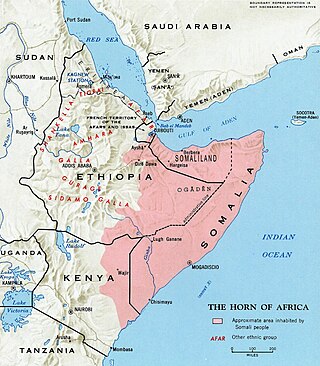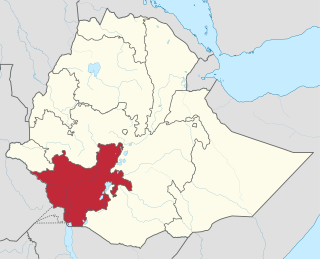
The Cushitic languages are a branch of the Afroasiatic language family. They are spoken primarily in the Horn of Africa, with minorities speaking Cushitic languages to the north in Egypt and Sudan, and to the south in Kenya and Tanzania. As of 2012, the Cushitic languages with over one million speakers were Oromo, Somali, Beja, Afar, Hadiyya, Kambaata, and Sidama.
Afar is an Afroasiatic language belonging to the Cushitic branch. It is spoken by the Afar people inhabiting Djibouti, Eritrea and Ethiopia.

Somali is an Afroasiatic language belonging to the Cushitic branch. It is spoken as a mother tongue by Somalis in Greater Somalia and the Somali diaspora. Somali is an official language in Somalia and Ethiopia, and a national language in Djibouti as well as in northeastern Kenya. The Somali language is written officially with the Latin alphabet although the Arabic alphabet and several Somali scripts like Osmanya, Kaddare and the Borama script are informally used.
Beja is an Afroasiatic language of the Cushitic branch spoken on the western coast of the Red Sea by the Beja people. Its speakers inhabit parts of Egypt, Sudan and Eritrea. In 2022 there were 2,550,000 Beja speakers in Sudan, and 121,000 Beja speakers in Eritrea according to Ethnologue. As of 2023 there are an estimated 88,000 Beja speakers in Egypt. The total number of speakers in all three countries is 2,759,000.

The Southern Nations, Nationalities, and Peoples' Region was a regional state in southwestern Ethiopia. It was formed from the merger of five kililoch, called Regions 7 to 11, following the regional council elections on 21 June 1992. Its government was based in Hawassa.
Bench is a Northern Omotic language of the "Gimojan" subgroup, spoken by about 174,000 people in the Bench Maji Zone of the Southern Nations, Nationalities, and Peoples Region, in southern Ethiopia, around the towns of Mizan Teferi and Shewa Gimira. In a 2006 dissertation, Christian Rapold described three varieties of Bench as "...mutually intelligible...varieties of one and the same language". Bench is the ancestral language of the Bench people.
Anfillo is a Northern Omotic language spoken in western Ethiopia by a few hundred people. The term Anfillo is used to refer both to the language and the people found in a small community in the Anfillo woreda, part of the Mirab Welega Zone. The language is on the verge of extinction as it is spoken only by adults above the age of sixty. All younger generations have shifted to Western Oromo as of 2007.
Lowland East Cushitic is a group of roughly two dozen diverse languages of the Cushitic branch of the Afro-Asiatic family. Its largest representatives are Oromo and Somali.
Bussa, or Mossiya, is a Cushitic language spoken in the Dirashe special woreda of the Southern Nations, Nationalities, and People's Region located in southern Ethiopia. The people themselves, numbering 18,000 according to the 2007 census, call their language Mossittaata.
Sidama or Sidaamu Afoo is an Afro-Asiatic language belonging to the Highland East Cushitic branch of the Cushitic family. It is spoken in parts of southern Ethiopia by the Sidama people, particularly in the densely populated Sidama National Regional State (SNRS). Sidaamu Afoo is the ethnic autonym for the language, while Sidaminya is its name in Amharic. It is not known to have any specific dialects. The word order is typically SOV. Sidaama has over 100,000 L2 speakers. The literacy rate for L1 speakers is 1%-5%, while for L2 speakers it is 20%. In terms of its writing, Sidaama used an Ethiopic script up until 1993, from which point forward it has used a Latin script.

The languages of Ethiopia include the official languages of Ethiopia, its national and regional languages, and a large number of minority languages, as well as foreign languages.
Libido is an Afroasiatic language of Ethiopia, which is spoken in the Mareko district Gurage Zone of the Southern Nations, Nationalities, and People's Region, directly south-east of Butajira. It has about 64,000 native speakers.

Borena is a zone in Oromia Region of Ethiopia. Borena is named after one of the two major subgroups of the Oromo People. Borena is bordered on the south by Kenya, on the west by the Southern Nations, Nationalities, and Peoples Region, on the north by West Guji and Guji and on the east by Dawa Zone Somali Region. The highest point in this zone is Mount Dara Tiniro. Cities and major towns in this Zone include Negele Borana, Moyale, Yabelo, Dubuluk, Mega, Millami, Surupa and Bakke.
Hadiyya is the language of the Hadiya people of Ethiopia. It is a Highland East Cushitic language of the Afroasiatic family. Most speakers live in the Hadiya Zone of the Southern Nations, Nationalities, and People's Region (SNNPR).
Burji language is an Afro-Asiatic language spoken by the Burji people who reside in Ethiopia south of Lake Chamo. There are over 49,000 speakers in Ethiopia, and a further 36,900 speakers in Kenya. Burji belongs to the Highland East Cushitic group of the Cushitic branch of the Afro-Asiatic family.
Highland East Cushitic, or Sidamic, is a branch of the Afroasiatic language family spoken in south-central Ethiopia. They are often grouped with Lowland East Cushitic, Dullay, and Yaaku as East Cushitic, but that group is not well defined and is considered dubious.
Alaba-Kʼabeena, also known as Wanbasana, is a Highland East Cushitic language spoken in Ethiopia by the Halaba and Kebena people in the Great Rift Valley southwest of Lake Shala, specifically in Alaba special district, the Kebena district of Gurage Zone, and the Goro district of Oromia Region. The literacy rate of native speakers in their language is below 1%, while their literacy rate in second languages is 8.6%; Alaba-Kʼabeena is taught in primary schools. It has an 81% lexical similarity with Kambaata. However, Fleming (1976) classifies Kʼabeena as a dialect of Kambaata, and Blench (2006) classifies both as dialects of Kambaata. The 2007 census in Ethiopia lists Alaba and Qebena as separate languages.
Kambaata is a Highland East Cushitic language, part of the larger Afro-Asiatic family and spoken by the Kambaata people. Closely related varieties are Xambaaro, Alaba, and Qabeena (K'abeena), of which the latter two are sometimes divided as a separate Alaba language. The language has many verbal affixes. When these are affixed to verbal roots, there are a large amount of morphophonemic changes. The language has subject–object–verb order. The phonemes of Kambaata include five vowels, a set of ejectives, a retroflexed implosive, and glottal stop.
The Ethiopian language area is a hypothesized linguistic area that was first proposed by Charles A. Ferguson, who posited a number of phonological and morphosyntactic features that were found widely across Ethiopia and Eritrea, including the Ethio-Semitic, Cushitic and Omotic languages but not the Nilo-Saharan languages.

Cushitic-speaking peoples are the ethnolinguistic groups who speak Cushitic languages natively. Today, Cushitic languages are spoken primarily in the Horn of Africa, with minorities speaking Cushitic languages to the north and south in Egypt, Sudan, Kenya, and Tanzania.





